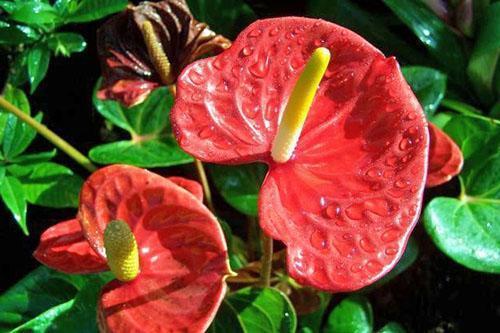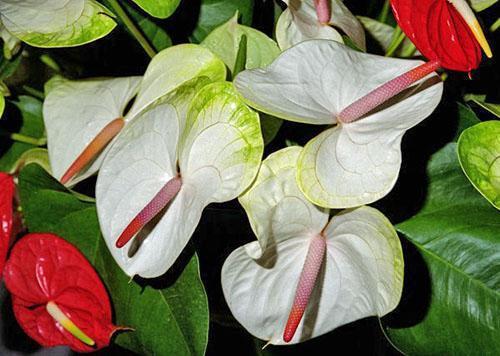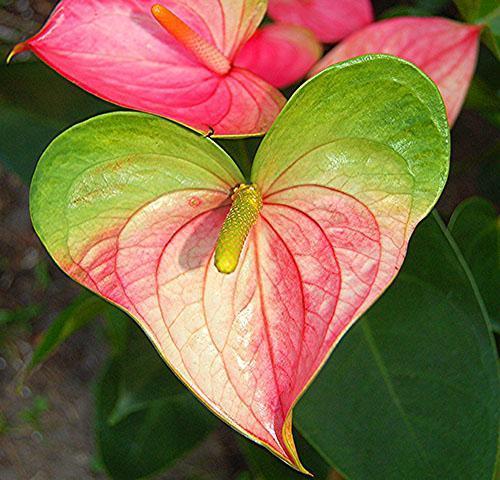Photo and description of varieties of anthurium
 Popular rumor compares anthurium with flamingos, and it owes its name to the similarity of the inflorescence to the tail. And the acquaintance of Europeans and Americans with representatives of a huge genus of anthuriums took place in the second half of the 19th century.
Popular rumor compares anthurium with flamingos, and it owes its name to the similarity of the inflorescence to the tail. And the acquaintance of Europeans and Americans with representatives of a huge genus of anthuriums took place in the second half of the 19th century.
Even then, the Dutch became interested in the spectacular André anthurium inflorescences, and in Hawaii, which became truly the second homeland of the inhabitants of the tropics of South America, the first industrial plantations were laid, and breeding work began.
Anthurium Andre (Anthurium andreanum)

Today, flower growers are offered a mass of Andre anthurium varieties and unique hybrids that amaze the imagination with a variety of shapes, colors and sizes of inflorescences. The native land of the species is the wooded mountain regions of Colombia, where Andre anthuriums grow at an altitude of approximately 2.5 km above sea level. Take a look tradescantia garden photo!
 This plant, with a height of 50 to 150 cm, leads the life of an epiphyte, for which its entire structure is adapted. Anthurium has a shortened succulent stem, on which long petioles of ovoid pointed leaves are tightly attached. The leaf plates are leathery, dense. The average leaf length is from 20 to 40 cm, and its width is almost two times less.
This plant, with a height of 50 to 150 cm, leads the life of an epiphyte, for which its entire structure is adapted. Anthurium has a shortened succulent stem, on which long petioles of ovoid pointed leaves are tightly attached. The leaf plates are leathery, dense. The average leaf length is from 20 to 40 cm, and its width is almost two times less.
Like other epiphytes, Andre anthurium, on the stem acquires many aerial auxiliary roots, which help the plant to receive nutrition and moisture from the atmospheric air. The species, according to the description of the anthurium, is distinguished by long flowering. Moreover, what many habitually consider to be an anthurium flower is its inflorescence, consisting of a veil or bracts and a cob, uniting many small flowers.
 The bedspread can be heart-shaped or oval, its fabric, as in the photo of the anthurium brown, leathery, with noticeable veins. On average, the bract can reach a length of 15–20 cm. Its width is somewhat narrower. As the flowers ripen, the bract folds back, completely revealing a light cream or yellow ear.
The bedspread can be heart-shaped or oval, its fabric, as in the photo of the anthurium brown, leathery, with noticeable veins. On average, the bract can reach a length of 15–20 cm. Its width is somewhat narrower. As the flowers ripen, the bract folds back, completely revealing a light cream or yellow ear.
It is thanks to the bright veil that the red anthurium was once seen among the riot of tropical colors. But today, in addition to varieties that delight flower growers, scarlet bracts, it is not uncommon for plants with a wide variety of colors and cobs and covers. You can see white, pink and even black anthuriums. There are varieties and hybrids with fancy colors that combine several bright shades at once.
 After pollination of the flowers, red or orange berries are formed on the inflorescences, inside which there are a couple of seeds. True, since modern flower growers are increasingly growing not varietal, but hybrid anthuriums, seed reproduction of culture gives way to vegetative methods... And on industrial plantations, tissue culture is used to obtain mass seedlings.
After pollination of the flowers, red or orange berries are formed on the inflorescences, inside which there are a couple of seeds. True, since modern flower growers are increasingly growing not varietal, but hybrid anthuriums, seed reproduction of culture gives way to vegetative methods... And on industrial plantations, tissue culture is used to obtain mass seedlings.
This approach allows you to create and offer to lovers of exotic plants varieties of anthurium never found in nature.An example of this is the anthurium shown in the photo with two bracts or complex interspecific hybrids with an unusual shape of the veil, miniature or, conversely, very large inflorescences.
Anthurium scherzerianum
 A well-known variety of anthurium to flower growers, which at first glance draws attention thanks to a bizarrely twisted elongated inflorescence. Wild Scherzer anthuriums were found in Guatemala and Costa Rica, where plants were chosen by rather humid tropical forests at a level of one and a half thousand meters above sea level.
A well-known variety of anthurium to flower growers, which at first glance draws attention thanks to a bizarrely twisted elongated inflorescence. Wild Scherzer anthuriums were found in Guatemala and Costa Rica, where plants were chosen by rather humid tropical forests at a level of one and a half thousand meters above sea level.
A perennial herbaceous culture lives both on the forest floor and on large woody plants. The height of an adult specimen of Scherzer's anthurium reaches 30–40 cm. Like Andre's anthurium, this species has a trunk either strongly shortened or absent altogether.
 Wedge-shaped or pointed-elliptical foliage is dense, saturated green. The surface of the leaf plate, reaching 20-30 cm in length, is matte, dense to the touch.
Wedge-shaped or pointed-elliptical foliage is dense, saturated green. The surface of the leaf plate, reaching 20-30 cm in length, is matte, dense to the touch.
Flowering can be year-round, but it peaks between February and July. Unlike anthurium Andrianum, the inflorescence is not straight, but curved, but in cultural forms it looks like a spiral. The cover is oval, less often cordate. In wild forms, both the ear and the bracts are most often colored red or scarlet.
The peculiarity of the flowering of this variety of anthurium is that, due to its structure, in plants only transfer from one flower to another is possible. The main pollinators in nature are insects. At home, where today Scherzer's anthurium is found more and more often, you have to use manual methods of transferring pollen.
 At the moment, many varieties and hybrids have been bred with different colors of inflorescences and the size of the plant itself. An example of this is the Amaretti anthurium shown in the photo, a houseplant with unusual former bracts strewn with bright red spots.
At the moment, many varieties and hybrids have been bred with different colors of inflorescences and the size of the plant itself. An example of this is the Amaretti anthurium shown in the photo, a houseplant with unusual former bracts strewn with bright red spots.
There are both tall varieties, forming a rosette of 60 cm in height, and small anthuriums, blooming with a plant diameter of less than 10 cm.
Anthurium Lindenianum
 It is not so common to see Linden's pink anthurium in culture, although the flowering of this variety in beauty and duration is not inferior to Andre or Scherzer's anthurium.
It is not so common to see Linden's pink anthurium in culture, although the flowering of this variety in beauty and duration is not inferior to Andre or Scherzer's anthurium.
Like many other species, this one naturally lives in Colombia, growing either under trees, on the moist humus-rich soil of the rainforest, or settling on the plants themselves, like a true epiphyte.
The radical difference of the species is the tetrahedral section of the petioles and the beautiful pointed-heart-shaped form of dense glossy leaves. On a leaf plate up to 30 cm long, lighter veins with an olive tint are clearly visible. Young foliage is easy to distinguish by its brighter juicy shade, adult leaves are dark, leathery.
 Unlike Andre anthurium with a red bracts, this variety even in the wild forms an oval blanket of a pure pink hue, narrowed to a pointed tip. On a high, up to 40 cm, peduncle, a straight, white or cream cob is formed. Flowering is accompanied by the spread of a pleasant smell.
Unlike Andre anthurium with a red bracts, this variety even in the wild forms an oval blanket of a pure pink hue, narrowed to a pointed tip. On a high, up to 40 cm, peduncle, a straight, white or cream cob is formed. Flowering is accompanied by the spread of a pleasant smell.
It is interesting that this is one of the oldest varieties of anthurium cultivated by man, but it can be found not in home collections, but more often in gardens. In addition, Linden's anthurium is used to obtain interspecific hybrids.
Crystal Anthurium (Anthurium crystallinum)
 Since 1875, another species of anthurium, crystal anthurium, which in nature lives in many wooded areas of Peru and Colombia, has acquired the status of a cultivated plant.
Since 1875, another species of anthurium, crystal anthurium, which in nature lives in many wooded areas of Peru and Colombia, has acquired the status of a cultivated plant.
If the above descriptions of anthuriums were given, attracting attention with beautiful flowering, then this variety stands out with bright decorative foliage, which is in no way inferior to spectacular alocasia leaves.
The maximum height of the crystal anthurium stem at home barely reaches a meter, while the trunk is densely covered with the main asset of the plant - velvety heart-shaped leaves.On which bright relief veins are clearly outlined. The length of the leaf plate varies from 20 to 40 cm, and its width is slightly less.
If young leaves can have a purple color, then with age, the green color on them becomes more saturated and darker. Cuttings of leaves are long, thin, drooping. The back of the leaf is whitish or silvery green.
 Although flowering, like other types of domestic anthuriums, is very long-lasting, it cannot be called decorative or spectacular. Anthurium flower stalks, as in the photo, reach a length of 40 cm and have a yellowish or pink-cream color.
Although flowering, like other types of domestic anthuriums, is very long-lasting, it cannot be called decorative or spectacular. Anthurium flower stalks, as in the photo, reach a length of 40 cm and have a yellowish or pink-cream color.
The coverlet is much smaller than the cob, which spreads the pungent aroma of cloves, and is sometimes difficult to distinguish. Its width is only 2 cm, and its length does not exceed 9 cm. The color of the bedspread is:
- white;
- greenish;
- dull purple.
Today there are many hybrid forms of beautifully blooming and decorative leafy anthuriums, where crystal anthurium was used when crossing.
Anthurium hookeri
 Although the plant is rarely grown in indoor culture, it perfectly tolerates all the hardships of home conditions and decorates any interior. In the wild, this species of anthurium can still be found today in the Lesser Antilles, in the rainforests of Suriname, Trinidad and in parts of Guiana.
Although the plant is rarely grown in indoor culture, it perfectly tolerates all the hardships of home conditions and decorates any interior. In the wild, this species of anthurium can still be found today in the Lesser Antilles, in the rainforests of Suriname, Trinidad and in parts of Guiana.
The diameter of the adult rosette of the anthurium shown in the photo is 150–250 cm, the height is about 60 cm. The stem is poorly expressed, the leaves are large, elliptical, narrowed towards the base. On closer inspection, a pattern of tiny black spots is visible on the leaf plates of a bright green hue. In comparison with other species and varieties of anthurium, in this case the leaf petioles are very short and barely reach 4 cm in length.
 It is not easy to achieve flowering and appearance on the anthurium of purple or dirty purple ears with small green bracts at home. If this succeeds, an almost meter-long anthurium peduncle is formed, as in the photo, topped with an ear about 30 cm long and an oblong bracts, slightly shorter than the inflorescence. After pollination, juicy berries, white with a red blush, ripen on the cob.
It is not easy to achieve flowering and appearance on the anthurium of purple or dirty purple ears with small green bracts at home. If this succeeds, an almost meter-long anthurium peduncle is formed, as in the photo, topped with an ear about 30 cm long and an oblong bracts, slightly shorter than the inflorescence. After pollination, juicy berries, white with a red blush, ripen on the cob.
Climbing Anthurium (Anthurium scandens)
 According to the description of anthuriums, most often grown at home, these are plants that practically do not have a real stem. But it turns out there are exceptions.
According to the description of anthuriums, most often grown at home, these are plants that practically do not have a real stem. But it turns out there are exceptions.
It is often found in the collections of aroid lovers, climbing anthurium. The plant is a liana-like epiphyte that forms long shoots covered with oval leathery leaves and thick aerial roots. In the forests of Central and South America, such thick roots help him climb not only the trunks of trees, but also fix on the rocks.
 The flowering of the anthurium shown in the photo does not differ in decorativeness, but the ripening berries greatly adorn the anthurium. Unlike other members of the genus, which form orange or red fruits, the berries of the climbing anthurium are white or purple. They are formed in place of a yellowish or green ear, slightly covered with a narrow green bracts. Since it blooms almost constantly, several small attractive brushes with berries can be seen on the potted plant at once.
The flowering of the anthurium shown in the photo does not differ in decorativeness, but the ripening berries greatly adorn the anthurium. Unlike other members of the genus, which form orange or red fruits, the berries of the climbing anthurium are white or purple. They are formed in place of a yellowish or green ear, slightly covered with a narrow green bracts. Since it blooms almost constantly, several small attractive brushes with berries can be seen on the potted plant at once.
Anthurium Wendlingeri
 This is one of the most interesting types of anthurium, grown both at home and in winter gardens. The description of Wendliger's anthurium says that it is a large epiphyte that forms stems up to 20 cm long. The leaves of the plant are leathery, elongated-lanceolate, of an even green color, attached to the stem with the help of short petioles. The length of the leaf plate reaches 80 cm, and its width does not exceed 11 cm.
This is one of the most interesting types of anthurium, grown both at home and in winter gardens. The description of Wendliger's anthurium says that it is a large epiphyte that forms stems up to 20 cm long. The leaves of the plant are leathery, elongated-lanceolate, of an even green color, attached to the stem with the help of short petioles. The length of the leaf plate reaches 80 cm, and its width does not exceed 11 cm.
A distinctive feature of this variety of anthurium is the branching aerial roots that compete in length with the foliage and have a green or brown color.
Long, cob-shaped inflorescences and stipules twisted into regular spirals give the plant a special decorative effect.The length of the cob can vary from 13 to 42 cm, and its diameter is from 3 to 7 mm. Pale green or yellowish inflorescences stand out brightly against the background of dark foliage, but the bedspreads, also rolled into a tight spiral, are not always noticeable. They are quite thin, elongated, and tinged with purple or purple tones. With a width of only about a centimeter, the length of the bracts often does not exceed 11-15 cm. Such purple anthurium is difficult to use in cutting, but it will perfectly decorate an interior or a greenhouse.